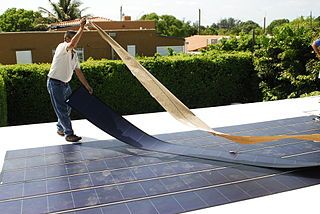From Stanford University: Peel and Stick Solar Photovoltaics
A friend sent me this article on “peel and stick” solar PV, and asked what I thought. In particular, he wanted to know if it has implications for transportation.
I think the future will bring us all manner of applications for PV that we don’t have today, including:
• Building-integrated photovoltaics (BIPV), where roofs, and even the walls and windows, are made with PV, as opposed to solar panels being installed on top of traditional construction materials.
• Wearable PV, woven into hats, shirts, etc., for charging personal electronic devices, and
• The stuff described in the article, i.e., thin-film, in hundreds of other formats and applications.
The trajectory by which PV applies to transportation, however, is limited by the math and physics of solar. In a good latitude with no clouds in the middle of the day, about 100 watts of solar power is incident per square foot. Thin-film is currently a bit under 10% efficient, but let’s say we can improve that to 30%, so we get 30 watts, or about 1/25th of a horsepower per square foot. Thus even a 10 HP engine would require 250 square feet, many times larger than the roof of a car.
This is why we’re working so hard to improve our batteries, i.e., to create better energy density and lower cost; transportation really does require energy storage.
This is also why we’re finding it so hard to replace gasoline; it’s an easily dispensed product whose energy density is 35 kilowatt-hours/gallon, which makes it super convenient. Of course, it’s also ruining our planet in several different ways simultaneously: politically, economically, socially, medically, and environmentally. Thus, there are trade-offs that need to be taken seriously.


There are niche transport markets where these panels even with current efficiencies can be very attractive. As far as These do not generally use the power generated to propel the vehicle, but rather provide a significant contribution to vehicle electrical loads especially when the vehicle is stationary.
Refrigerated freight trucks are one example. On sunny days, a flexible thin film array on the roof of the truck should provide enough power to keep the trailer refrigerated while the driver takes a break – without running the engine. This saves a considerable amount of fuel and pollution as engines (which would otherwise be left running to drive a generator) have very poor efficiency at low part loads below 10%. In other trucks there are “hotel loads” (many drivers more or less live in their trucks), so run lights, fridge, air conditioning etc. even when the truck is stationary.
Ambulances – these vehicles are in operation almost continuously, and run fridges, medical equipment, lights, and possibly air conditioning. As such, electrical loads are high, and this can have a heavy impact on the vehicle batteries which then require regular replacement. Solar in this situation can take some of the loads off the batteries especially air conditioning loads in hot climates, increasing battery life, and improving vehicle reliability and fuel consumption.
Recreational vehicles – again there are significant electrical loads in a stationary vehicle so solar can make a very useful contribution.
In all of the above, solar will almost certainly be less expensive than providing the same amount of electricity by running the engine on part load.